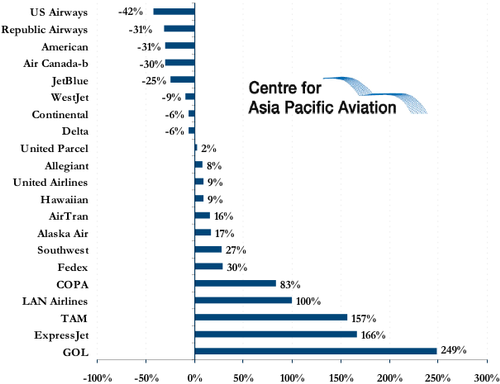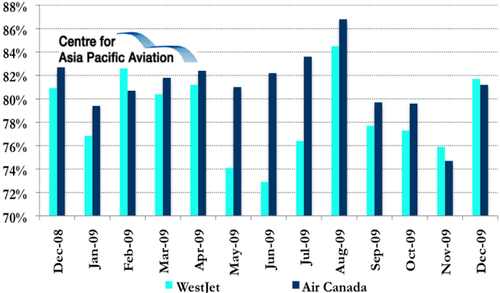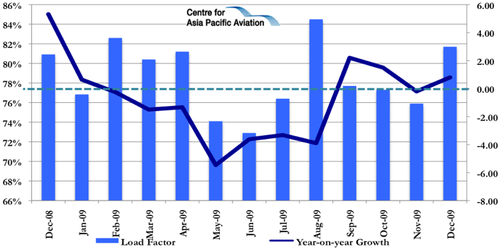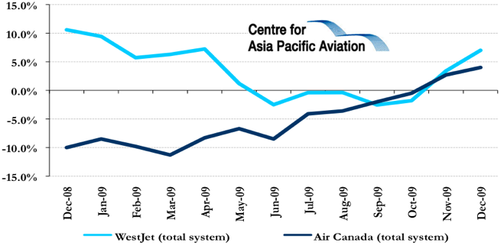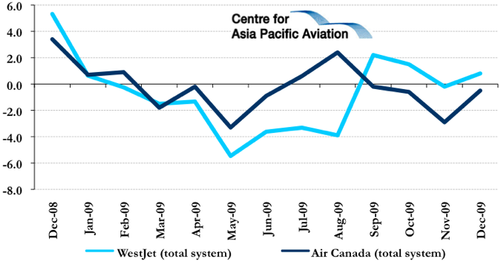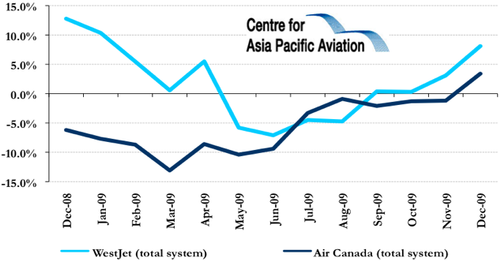2010 to be a “transformational” yet “tough” year for Air Canada and WestJet
Air Canada and WestJet continued to face challenging operating conditions in Dec-2009, characterised by continued economic weakness, soft travel demand and aggressive pricing. Winter storms/delays and increased security measures at Canadian airports added to the strain.
WestJet expecting double-digit RASM reduction in 4Q2009
WestJet CEO, Sean Durfy, upon the release of the carrier's Dec-2009 traffic results, stated it expects 4Q2009 RASM to be "in line" with its previous guidance of an 11-13% decline.
However, this is an improvement from a 15.5% decline in 3Q2009. Mr Durfy, in late Dec-2009, stated the airline is "still nervous" about the general outlook for the North American economy, adding, "it's tough and it's going to be tough". The CEO, who added that the carrier is still seeing the effects of the recession, stated he expects a recovery in either 2Q2010 or 3Q2010.
WestJet's 2009 share price down 9% in 2009; Air Canada's slumps 30%
Versant Partners, meanwhile, raised its stock target for WestJet, which experienced a 9% share price reduction in 2009, from CAD14 to CAD16, on expectations of traffic and unit revenue improvements in 2010. Air Canada's share price was much worse affected in 2009, losing 30% of its stock market value last year.
North America carriers' share price growth in 2009
Fare weakness amid global financial downturn
The recent revenue softness for WestJet is attributed to the challenges experienced in the transition to the new SabreSonic reservations system (WestJet has stated its transition to a new reservation system will negatively affect its 4Q2009 revenues) and also reflects a reduction in the airline's average fare.
Mr Durfy previously stated WestJet is now offering more fare sales than in the past, as passengers continue to use discretion when purchasing fares amid the global financial downturn and competitor, Air Canada, adopts aggressive pricing strategies.
Record load factor for WestJet in Dec-2009
However, the fare reductions have helped the Canadian LCC report a record load factor of 81.7% in Dec-2009, a 0.8 ppt year-on-year improvement and at the higher end of the carrier's "optimal" operating range of 78-82%. The carrier commented that it is "very pleased" with this load factor result.
WestJet's load factors now stronger than Air Canada's for second consecutive month
WestJet's load factors outperformed Air Canada's in the month. Air Canada's load factors have been stronger than WestJet's in all but three of the past 16 months.
WestJet and Air Canada PLF (%): Dec-2008 to Dec-2009
The LCC, while not disclosing monthly traffic numbers, stated it transported 42,000 additional guests in the "busy" travel month of Dec-2009, compared to the same month in 2008, with the carrier adding that it has benefited from WestJet Vacations' increased popularity, a number of new vacation destinations and "considerable progress" in its call centre service levels since its reservation system cutover in Oct-2009.
WestJet passenger load factor and passenger load factor growth: Dec-2008 to Dec-2009
In the full year, WestJet reported an average load factor of 78.7%, a 1.4 ppt reduction, as the carrier's 2.6% capacity (ASMs) growth exceeded its traffic (RPMs) growth.
WestJet traffic highlights: FY2009
|
|
2009 |
% Change |
|---|---|---|
|
Traffic RPMs (bill) |
13.835 |
+0.8% |
|
Capacity ASMs (bill) |
17.588 |
+2.6% |
|
Load factor (%) |
78.7% |
-1.4 ppts |
WestJet and Air Canada increasing capacity again
WestJet reported a second consecutive month of capacity growth in Dec-2009 following five consecutive months of capacity reductions between Jun-2009 and Oct-2009, with capacity (ASMs) increasing 7.0%, which was offset by traffic (RPMs) growth of 8.1%.
WestJet traffic highlights: Dec-2009
|
|
Dec-2009 |
% Change |
|---|---|---|
|
Traffic RPMs (bill) |
1.279 |
+8.1% |
|
Capacity ASMs (bill) |
1.565 |
+7.0% |
|
Load factor (%) |
81.7% |
+0.8 ppts |
This capacity growth is expected to continue, with the carrier unveiling five new routes and expanded frequencies on 19 existing routes as part of its Summer 2010 flight schedule. It plans to receive a further five aircraft in 2010, for a total of 91 aircraft. The carrier also stated that it hopes to operationalise its codeshare agreement with Southwest Airlines in 2010, in addition to its Air France-KLM agreement, adding that there could be "two to four other partners".
Air Canada is now growing its capacity again, after well over a year of contraction. During Dec-2009, Air Canada's capacity (ASMs) expanded by 4.0%, for two consecutive months of capacity growth.
WestJet and Air Canada capacity (ASMs) growth: Dec-2008 to Dec-2009
However, this capacity (ASMs) growth of 4.0% in Dec-2009 was not matched by traffic (RPMs) growth, resulting in a 0.5 ppt year-on-year load factor reduction, to 81.2%, in Dec-2009.
Air Canada traffic highlights: Dec-2009
|
|
Dec-2009 |
% Change |
|---|---|---|
|
Traffic RPMs (mill) US trans-border |
3,855 1,229 627 |
+3.4% +1.0% -2.8% |
|
Capacity ASMs (mill) US trans-border |
4,748 1,537 818 |
+4.0% +2.4% -1.3% |
|
Load factor (%) US trans-border |
81.2% 80.0% 76.7% |
-0.5 ppts -1.1 ppts -1.1 ppts |
This represents the fourth consecutive month of year-on-year load factor reductions for the Canadian flag carrier, indicating that its return to capacity growth is occurring earlier and at a greater extent than current demand supports.
WestJet and Air Canada PLF (year-on-year growth): Dec-2008 to Dec-2009
Meanwhile, Air Canada's 3.4% traffic (RPMs) growth in Dec-2009 represents the first month of traffic growth in over 16 months. The largest traffic reduction in this period was reported in Mar-2009, of 13.1%, the same month that the carrier reported its largest capacity (ASMs) reduction of 11.3%.
Air Canada and WestJet RPM growth: Nov-2008 to Nov-2009
Outlook: Conditions on the improve, but a prolonged recovery period expected
Canada's two major carriers, Air Canada and WestJet, have not been immune to the global economic crisis, although WestJet has managed to be one of only a few profitable airlines in North America during the downturn (Air Canada was profitable in 3Q2009 but was unprofitable in 1H2009).
However, the Canadian market has not been as badly affected as its US neighbour, with the carriers benefiting, to varying degrees, from operating in a duopoly home market. WestJet and Air Canada currently have a combined 82% domestic capacity share, with the country's third largest domestic airline, Porter Airlines, commanding only a 3.0% capacity share, according to OAG data. The two carriers have a combined 46.2% international capacity share.
While the outlook for 2010 is more positive than 2009, both Air Canada and WestJet are expecting a prolonged recovery period. Air Canada's CEO, Calin Rovinescu, in Dec-2009, stated he expects it will "take a full year for the business travel to get to levels that are sustainable, while WestJet is foreseeing a recovery in 2Q2010 or 3Q2011.
However, in the lead up to this recovery, conditions will likely show continuous signs of improvement in what, according to Mr Rovinescu is likely to be a "transformational year" for Canadian aviation. He added that Air Canada expects to see less discounting on fares in 2010, as the carrier aims to boost revenues by USD95.8 million, with WestJet expected to follow suit to repair its unit revenue profile.
